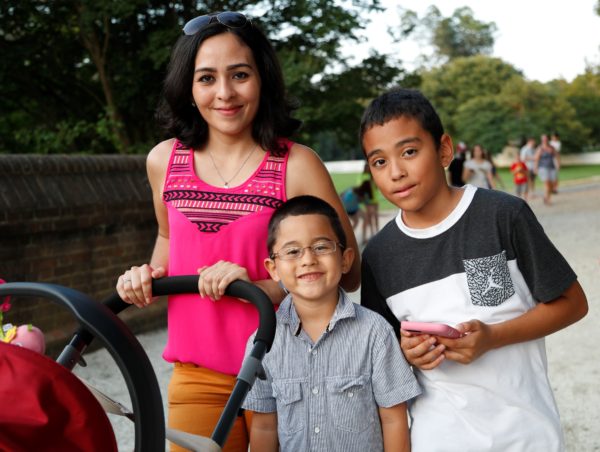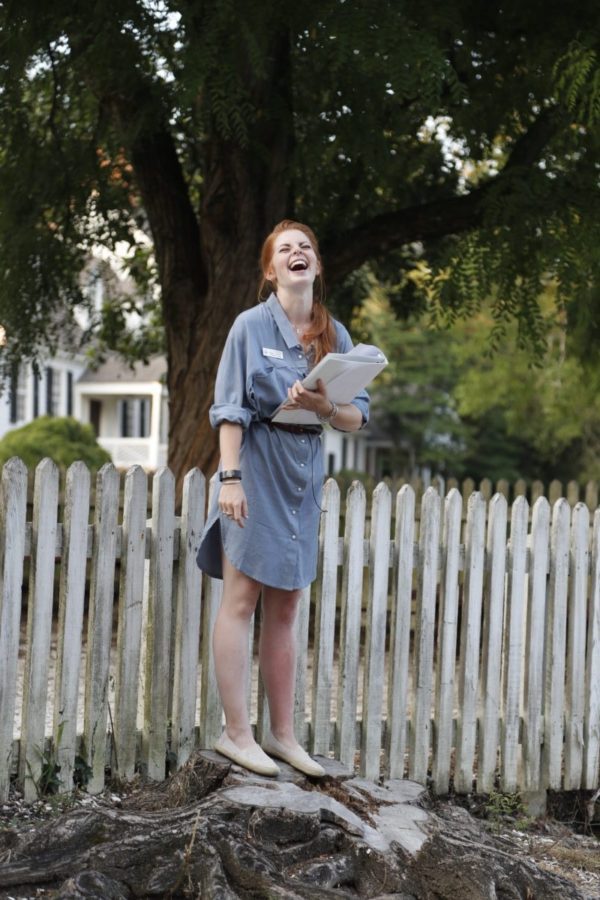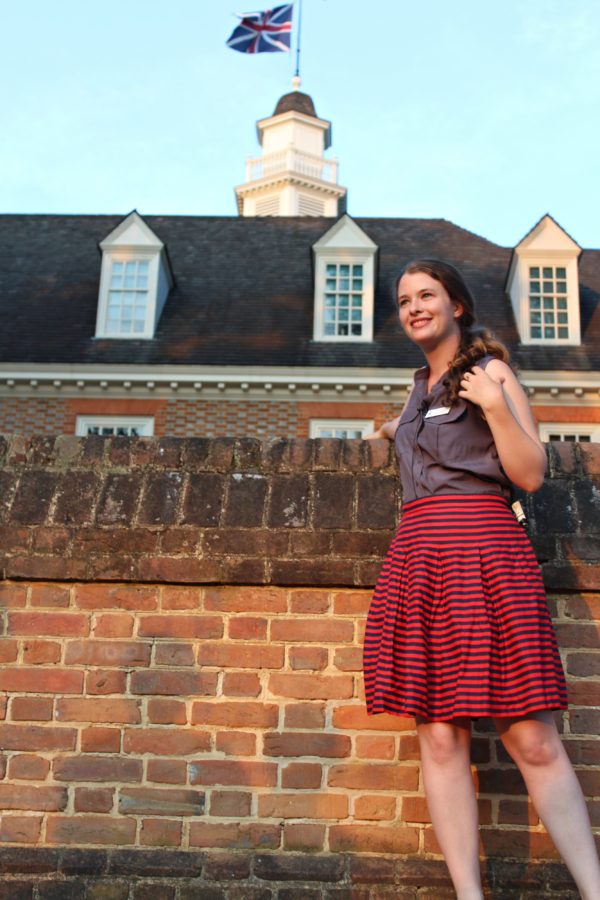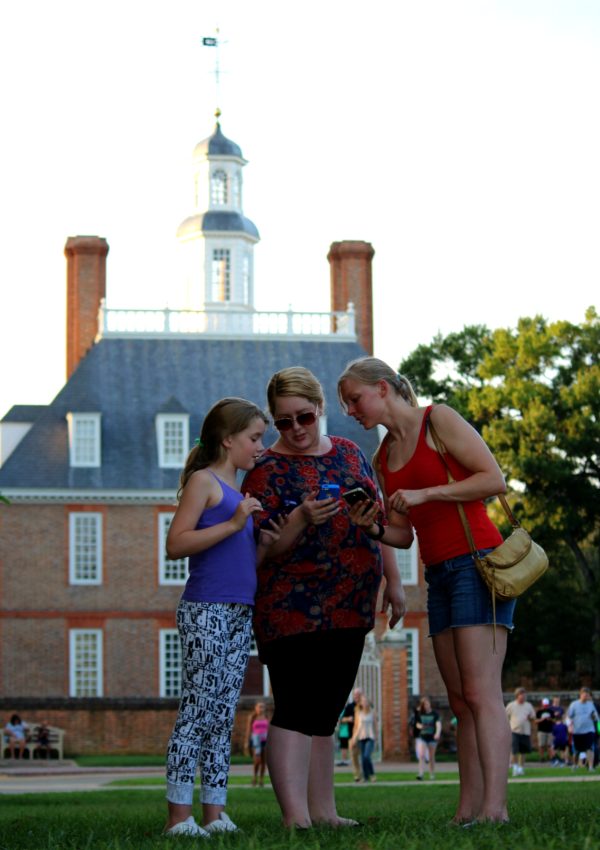
Last night was our first ever social meet-up and we are happy to report it was a rousing success! An estimated 250-300 people of all different ages from as far away as Fredericksburg and Carrollton made the trip into the Historic Area to join the Pokémon GO Revolution. Local Bruce Hornsby even checked in on the fun.
The sea of eager players started at Chowning’s Tavern, made its way down Palace Green, around the Capitol, and back up Duke of Gloucester Street pretty easily. It was about a mile and the best part was each person could go at his or her own pace. Up and down Nicholson and then DoG—you heard the squeals and excitement of the young kids (okay, some adults too) catching rare Pokémon.
 Perhaps one of my favorite moments was when this adorable little boy caught his very favorite—Pikachu—in front of the Greenhow Store. He was so excited, his little hands were shaking as he tried to steady his phone.
Perhaps one of my favorite moments was when this adorable little boy caught his very favorite—Pikachu—in front of the Greenhow Store. He was so excited, his little hands were shaking as he tried to steady his phone.

Character Interpreter Emily Doherty and Apprentice Joiner Amanda Doggett stopped at all four gyms (Palace, Tucker House, Capitol, and Raleigh Tavern). They also pointed out several PokéStops along the way, introducing the history of the sites and offering up fun facts that appealed to all ages.
Now, we know not everyone could make it last night, so we thought we’d provide a list of PokéStops for you and give you some of the information we shared. And if you can’t wait until the next tour (yes—we’re hoping to do it again!), grab your pass or ticket and come back any day. You can review the history with your kids beforehand or print this out and take it with you. Make it a fun, educational experience for the family. And please enjoy our slideshow of highlights. We’d love for you to share your images and comments at the bottom of this post!
HISTORIC AREA PokéStops
Anderson Armoury: Reconstructed in the last five years, in the summer, the Anderson Armoury offers four trade shops to be seen in one location: Historic Foodways, Tinsmiths, Blacksmiths, and the Military Artificers. During the early years of the Revolutionary War, Williamsburg Blacksmith James Anderson expanded his small, commercial site into a Public Armoury. As Public Armourer, Anderson maintained and manufactured many of the weapons, tools, and other equipment used by the American military. The Armoury had a diverse workforce of more than 40, working in several shops and fed from the site’s kitchen. On certain days, you will be able to see (and smell) cooking demonstrations here!
Booker Tenement: A building under a 100-year lease by Colonial Williamsburg, the Booker was a structure with a horrible location. Next to a 19th-century tan-yard and a slaughterhouse, it was clearly unloved by the man who erected it by 1826, Richard Booker. The future of this building is unknown, but we do maintain its upkeep.
Bruton Parish Church: Bruton Parish is the first Anglican Church, erected in 1660. Many patriots attend service here including Thomas Jefferson, George Washington, Patrick Henry, and George Mason—just to name a few. The church served as a hospital and storehouse during the Battle of Yorktown in 1781, as well as during the Civil War.
Cabinetmaker: This historic trade makes high style furniture and furnishings. Anthony Hay, a prominent Scot known for his ability to communicate “plain and neat” taste of the Virginian, owned the shop in 18th-century Virginia.
Charlton Coffeehouse: Coffee houses in the 18th century not only served as places to get strong beverages like coffee and chocolate, but also as the best places to get the town gossip and for the men to acquire news of politics and goings-on about the colonies during the day. You could gamble and play cards here too—making the coffeehouse akin to a day-time tavern.
Chowning’s Tavern: This was a popular spot for the “ordinary sort.” As it was in the 18th century, Chowning’s today is a hub for music, gossip, good food, and gambling.
Everard House: This house was built 1718 by keeper of Williamsburg’s Magazine, Thomas Brush. Inside you’ll find an elaborate staircase and balusters. Thomas Everard purchased it in the 1750s. He gained clout in Williamsburg as clerk of the York county courts, as well as owning 600 acres of land and becoming an outspoken voice in favor of independence.
Geddy: This is one of Colonial Williamsburg’s original buildings, which once housed the diverse Geddy family of trades people, who handled everything from silversmithing to watch repair. It features a conglomeration of various styles of architecture, from Greek to Italian influence, and an L-shape, which was uncommon in Williamsburg.
Greenhow Tenement: John Greenhow was a master of importation and exportation in the 18th century; his store carried wares of all varieties. If he didn’t have it, you didn’t need it!
King’s Arms Tavern: Jane Vobe’s tavern appealed to the gentry. She described it as “where the best people resorted.” Vobe inherited the establishment from her deceased husband and was a successful businesswoman here in Williamsburg.
Magazine: In 1714, the General Assembly asked Governor Alexander Spotswood to build “a good substantial house of brick” precisely to protect the colony’s arms and munitions. The night of April 20, 1775, Lieutenant Henry Collins stole toward the capital with a squad of royal marines from H.M.S. Magdalen anchored in Burwell’s Bay on the James River. Their orders, straight from Governor Dunmore, were to empty the arsenal and disable the muskets stored there. This was the spark…. of a Revolution.
McKenzie Shop: Owned by a Dr. Kenneth McKenzie, doctor of Physics, who apparently lived here from October 1747 to December 1751, at which point the property was leased or sold to Philip Grymes, Receiver General of Virginia, for the use of the Governor while the Palace was being conditioned for his occupancy.
Military Encampment: The tents and military supplies on the corner of Nicholson and Botetourt Streets help us interpret the soldier’s life. During the Revolution the Virginia State Garrison Regiment was stationed in nearby barracks and frequently marched down DoG Street. The site is called Ravenscroft.
Nicholson Store: A lot that changed hands frequently, shrank and grew many times over history, the Nicholson store was a shop in which William Pasteur, surgeon, sold a variety of goods and drugs.
Palmer House: This tall brick home on West Duke of Gloucester Street has been called the Kerr House, the Vest Mansion, and the Palmer House in its nearly 250 years, but it may be known best today as the house with the Christmas apples!
Peyton Randolph House: Peyton Randolph was an important figure in Williamsburg. He was speaker of the House of Burgesses and elected presiding officer to the first Continental Congress in Philadelphia. The oldest parts of the house date back to 1715, with later additions. Its sprawling back yard and outbuilding speak to importance of face-value in a home in the 1700s.
Play Booth Theatre: This is the site of first theater in Williamsburg in 1717. Shortly thereafter, the site moved near the Capitol. The new site offered the first theatrical performance in British North America in 1752 under Lewis Hallum’s “company of comedians.” It’s shaped like a shoe box which was typical of English theaters—a third of structure is the stage. The other 2/3rds are seating, arranged like modern theaters with higher seats with “box seats,” the “pit” for the middling sort, and the “gallery” or balcony for the “lesser” sort. Theater was an important method of recreation and cultural expression, enjoyed by everyone from the gentry to even slaves.
Shields Tavern: Shields, one of around seven licensed taverns in Williamsburg in the period, catered to the lesser gentry and upper middling sort of characters. The higher gentry favored the Raleigh and Weatherburn’s. This represents Shields at approximately 1750 where proprietor James Shields lived with his family.
William Pitt Store: Set up on the site of the former Davidson shop, the William Pitt store sells wares for children of all varieties. What is known of the Davidson shop is little: it is believed, according to advertisement in the Virginia Gazette, that as early as May 20, 1737 Robert Davidson was advertising medicines in Williamsburg: “All Sorts of Chemical and Galenical Medicines, faithfully Prepared and Sold by Robert Davidson and Thomas Goodwin, chymists, at Williamsburg.”
Wythe House: This stately Georgian was the home of George Wythe, signer of the Declaration of Independence and law instructor to Thomas Jefferson and John Marshall. It served as headquarters for Gen. Washington before the siege of Yorktown in the fall of 1781. It was later used as offices for W.A.R. Goodwin, “the father of Colonial Williamsburg.”
HISTORIC AREA GYMS
Capitol: This building represents the first capitol, where Virginia’s House of Burgesses first met in 1705. That building burned in 1747. It was rebuilt in the early 1750s and the legislature continued to meet there until the capital moved to Richmond in 1780. In between, Patrick Henry famously was accused of treason for railing against the Stamp Act in 1765. In 1793 its west wing was dismantled and the bricks sold off. The east wing burned down in 1832.
Governor’s Palace: Finished in 1722 after 16 years of building; home to seven governors, Patrick Henry and Thomas Jefferson. It was also the backdrop of a few scenes in the hit AMC show, TURN: Washington’s Spies.
Raleigh Tavern: Recently our experts determined that this famous tavern actually had a front porch, which we’re researching with an archaeological dig. A front porch will be added back in 2017. Inside, this was the place where the House of Burgesses retreated on more than one occasion to meet when the royal governor dissolved the legislature. It was here the people fought back and took steps toward revolution. It’s also the place where, at a 1760 dance, the future Rebecca Ambler rejected Thomas Jefferson’s marriage proposal.
St. George Tucker House: Tucker, a prominent figure and lawyer, was a Revolutionary War officer, scholar, and judge who boasted having the first “bathroom” in Williamsburg. An anomaly at the time, Tucker converted a dairy out back into a true “BATHroom,” outfit with a copper tub with a drain. While not currently an exhibition site, the Tucker was owned by the family until 1993.
MERCHANTS SQUARE GYM
Kimball Theatre
PokéStops IN AND AROUND MERCHANTS SQUARE
- Adams Memorial Garden (Corner of Boundary and Richmond Roads)
- WILLIAMSBURG Craft House
- DoG Street Pub
- Berret’s Big Blue Crab Wall
- Blackbird Bakery (look for the Colonial Soldier!)
- Mermaid Bookstore
- Rebecca Davidson Memorial benches on DoG Street
- Sons of Revolution (in parking lot 5)
- William & Mary’s Brown Hall
PokéStops NEAR the ART M- USEUMS
- Public Hospital
- Henry Street (near museum sign)
- Bicentennial Park
Special thanks to Lael White for all of the wonderful pictures and Rësa Curley & Dennis Mitchell for the fun video!




Man so cool
the Military Encampment paragraph: Nicholson and Francis streets do not intersect…they run parallel to each other, there is no “corner of Nicholson and Francis street”
Correct. Nicholson and Botetourt. Just testing to see who was paying attention. 🙂
Bruton Pariah?
Thank you, Marsha. It was most definitely a typo. We appreciate you so kindly pointing it out so that we could fix it. I just made the edit. I hope you’re having a wonderful day!
This was so much fun for my family. We live in the area and honestly don’t come much because we’ve been so much already that we get burnt out. This made it a whole new experience not only for us, but for our children as well. We plan on coming back more often to walk and enjoy the history along with Pokémon catching.
I was wondering if it’d be possible to get a copy of the picture that was taken of my family?.
Elizabeth - we’re so glad you enjoyed it! Sheri emailed you the pictures of your family (including one that didn’t make it into the post). We hope to see you all at the next event.
I work for C.W. and I brought my 13 year old son last to the Pokemon event. I cannot express my gratitude to Emily and Amanda for hosting this event. My son had a blast. I am not playing the game,but I enjoyed watching my fellow coworkers and their families enjoy the game My son had over 55 pokeballs when we went home. Today, I got to share my knowledge of where some of the best places were to catch the balls and where to go to find gems. It was great fun being able to share with our guests.
I see this as a way to get employees from all over the foundation together to do something they like to do. This is no different than a ghost walk in the evening. I look forward to the next walk or other event that is planned in the future.
Chistina - It was so nice meeting you and your son and we’re so glad you had a good time! We hope to do another meet-up soon so please, stay tuned!
I am so disappointed yet again!
Barbara, can you not get it throuh your thick head that it is people. Walking. Around. Holding. Phones. No different then what millions of people do every year at Colonial Williamsburg. But by all means, blindly hate a great event that brought hundreds of people in to enjoy the beauty of Colonial Williamsburg. Just because you grew up playing with a stick and a piece of string doesnt mean everything that anyone younger than you does is some sort of society destroing evil.